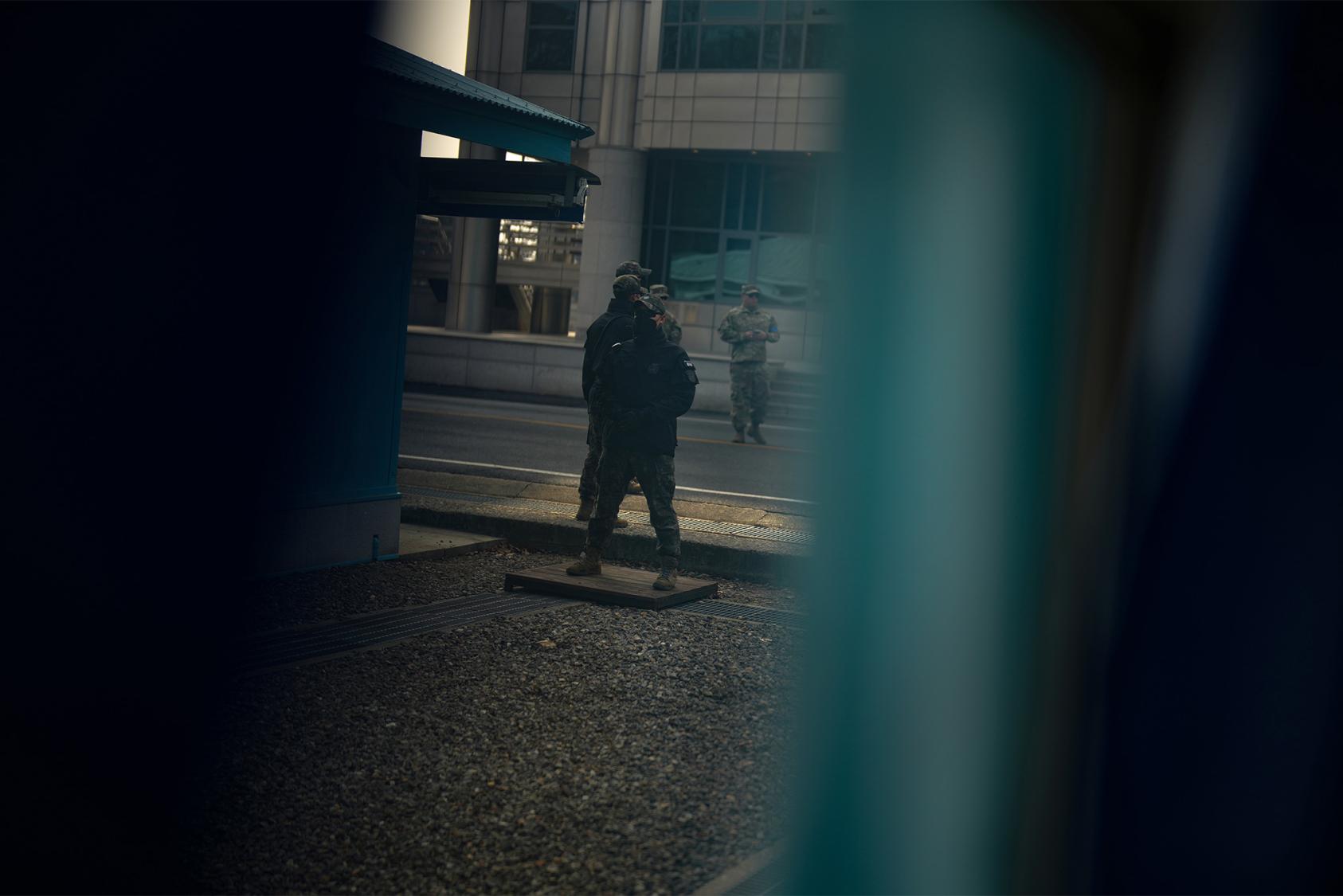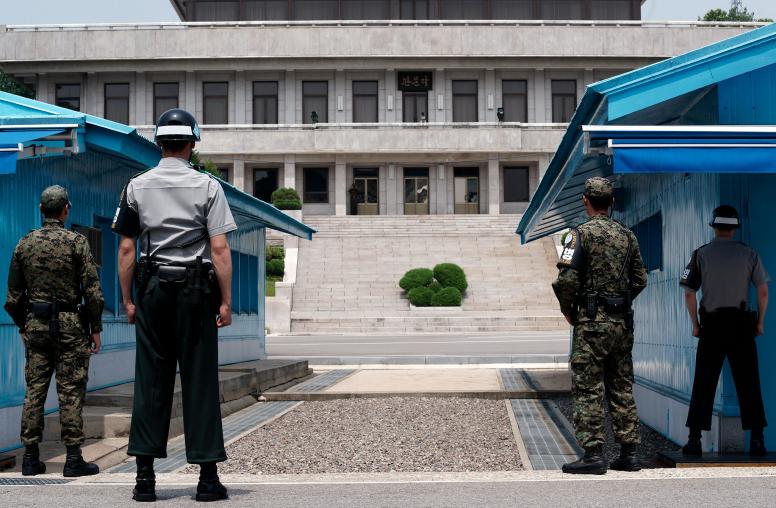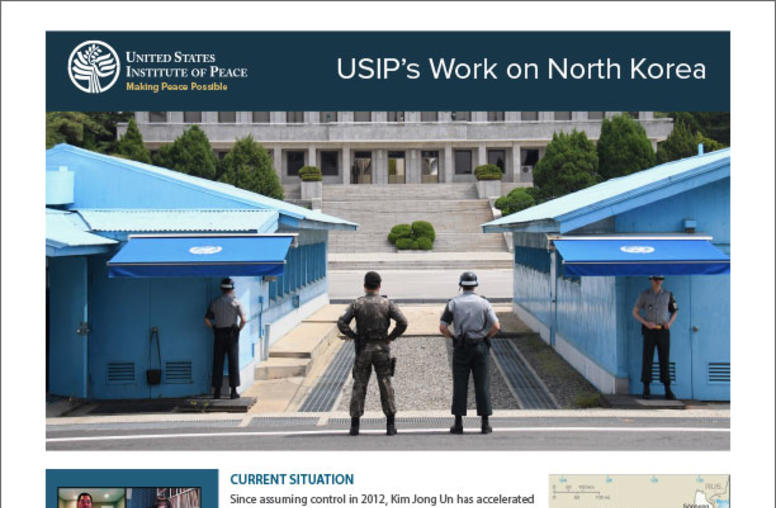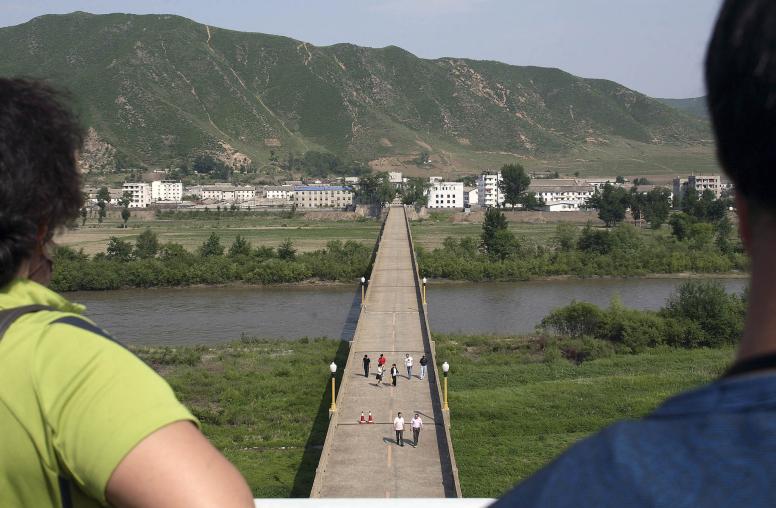Exploring Peaceful Coexistence with North Korea
The United States and South Korea’s prioritization of denuclearization above all else needs to change to fit the new reality.
This essay is part of a series, Pursuing Peaceful Coexistence with North Korea, that explores how the United States and South Korea can peacefully coexist with a nuclear North Korea.
The United States and North Korea coexist today in an antagonistic, high-risk stalemate. The Kim Jong Un government, feeling besieged by a “hostile” U.S. policy and fearing the potential for regime change, has centered its national defense strategy on strengthening deterrence through nuclear weapons. Facing this intractable nuclear threat, the Biden administration has reinforced a coercive, pressure-based approach that relies on diplomatic isolation, military deterrence and economic sanctions to contain, if not change, North Korea’s defiant behavior.

As a result, the two sides have not talked in over four years, have only engaged in official security discussions in one out of the last 11 years and do not appear to be prioritizing future diplomacy seriously. Similarly, their citizens are largely prohibited from visiting and interacting with each other.
More worrisome, the two sides are intensifying their military postures to perilous levels. North Korea has developed and tested an array of new nuclear weapon delivery systems, including hypersonic glide vehicles and solid-fuel long-range missiles, emphasized the deployment of tactical nuclear weapons and enacted the automatic use of nuclear weapons in its nuclear doctrine. Likewise, the U.S.-South Korea alliance has accelerated the deployment of nuclear-armed submarines, B-52 bombers and other U.S. strategic assets to the Korean Peninsula, increased the scope and scale of bilateral military exercises (and trilaterally with Japan), and sharpened provocative rhetoric about the end of the North Korean regime.
The United States has also led international efforts to isolate North Korea diplomatically while applying economic sanctions and financial measures to squeeze it out of the dollar-based global financial system. North Korea has coped, however, by bolstering ties with Russia and China, which all but removes further U.N. Security Council sanctions from the table, and engaging in cyber theft and other U.N.-proscribed activities to subsist economically and advance militarily.
The upshot is a dangerous, simmering situation on the Korean Peninsula that is one misstep away from boiling over into a catastrophic conflict. This status quo is untenable. Washington should explore a new modus vivendi with North Korea that reduces the risk of conflict, improves security and builds mutual trust and understanding in a tangible, proactive and realistic way.
The Golden Era of U.S.-North Korea Relations?
A hostile relationship between Washington and Pyongyang was not always the case. Even though they have never normalized diplomatic relations and continue to remain in a technical state of war, there was a period not too long ago when the United States and North Korea basically coexisted in relative peace. Between 1994 and 2008, the two countries engaged in meaningful, productive and sustained interactions across the diplomatic, military, economic and people-to-people dimensions, with mostly manageable levels of security tensions.
During this period, the two countries participated regularly in diplomatic dialogue to strengthen their respective security and reduce potential misperceptions. Their diplomats met often to implement the 1994 U.S.-DPRK Agreed Framework, address North Korea’s incipient ballistic missile program and explore a permanent peace treaty. In 1998, when Washington suspected a North Korean underground site of being nuclear-related, it negotiated visits to the facility to confirm that the site could not house nuclear operations.
Diplomacy continued even with setbacks. When North Korea conducted its first intermediate-range missile test in August 1998, the United States arranged senior-level meetings with North Korea, including former Defense Secretary William Perry’s visit to Pyongyang in May 1999 and an exchange of visits by Secretary of State Madeleine Albright and Jo Myong Rok, vice chairman of North Korea’s National Defense Commission, in 2000, to hear Pyongyang’s perspective and seek an end to its missile program.
Productive engagement also occurred beyond the diplomatic sphere. Between 1996 and 2005, U.S. Department of Defense officials worked side-by-side with Korean People’s Army officers in North Korea to recover and repatriate the remains of 153 U.S. servicemembers from the Korean War. U.S. congressional delegations, including members and staffers, periodically visited the country to share perspectives with North Korean government officials. Starting in 1995, numerous U.S. nongovernmental organizations established operations in North Korea to provide aid and assistance on health, agricultural and other humanitarian issues. Approximately 800 to 1,000 U.S. citizens traveled to North Korea every year to go on tours, reunite with family members or conduct academic and scientific exchanges, with minimal negative incidents. Also, North Korean scientific, academic and cultural delegations made dozens of trips throughout the United States to study agriculture, energy, health, business and law, as well as conduct taekwondo demonstrations.
Most importantly, during much of this time, security tensions remained relatively low. Between 1994 and 2002, North Korea conducted zero nuclear tests, only one ballistic missile test and did not reprocess any plutonium for fissile material. The environment began to worsen in 2002 when the Bush administration characterized North Korea as part of an “axis of evil” and scrapped the Agreed Framework due to North Korea’s development of a uranium enrichment facility. This led Pyongyang to withdraw from the Nuclear Non-Proliferation Treaty the following year. After the United States froze North Korean assets in a Macau bank out of money laundering concerns in September 2005, North Korea boycotted the Six-Party Talks for a year and conducted its first nuclear test, signaling a shift in its strategic calculus and a tougher road ahead for disarmament efforts. Yet despite all this, the two sides still engaged through the Six-Party Talks process (2003 to 2008) to achieve important outcomes, including North Korea’s delivery of 18,000 pages of nuclear declarations and destruction of a nuclear plant cooling tower in 2008, and even a New York Philharmonic performance in Pyongyang.
In essence, for 15 years, the United States and North Korea coexisted in relative peace — to the benefit of the people in both countries and the rest of the international community.
Pursuing Peaceful Coexistence Today
The situation today is different. After five additional nuclear tests and hundreds of ballistic missile and other military tests over the past 15 years, North Korea is de facto, and certainly for alliance planning purposes, a nuclear weapon country. It solidified this nuclear status in its constitution, and the U.S. intelligence community assesses that North Korea will not abandon it. In response, the U.S. government, other than then-President Donald Trump’s anomalous year of engagement, has implemented a comprehensive, sustained, and relentless international pressure campaign against North Korea, with the hope of coercing it back to the negotiating table.
The dynamics of U.S.-North Korea engagement have also reached uncharted territory. From the early 1970s up until 2019, it was mostly Pyongyang soliciting dialogue with Washington, which had the leverage and standing to accept, ignore or apply preconditions. Since 1992, the United States has chosen to engage with North Korea, but always prioritizing denuclearization on the agenda. Today, the tables have turned. It is now Washington seeking talks, ostensibly without preconditions, and Pyongyang that is shunning them. North Korea likely detects implicit preconditions in the proposal for unconditional talks — that they start at the working-level and they address denuclearization. In response to the most recent U.S. offer, Kim Yo Jong, the North Korean leader’s sister, stated that “[t]he sovereignty of an independent state can never be an agenda item for negotiations, and therefore, [North Korea] will never sit face to face with the United States for that purpose.”
The U.S.-South Korea alliance’s approach of prioritizing denuclearization above all else needs to change to fit the new reality. While the denuclearization objective originally began as an effort to reduce the North Korean threat and uphold the nonproliferation regime, it now tends to engender the opposite effect. A rigid, narrow focus on denuclearization has foreclosed opportunities for engagement and accelerated North Korea’s drive to attain a nuclear deterrent, while the constant failures to achieve it in the near term have fueled South Korean debates about pursuing indigenous nuclear capabilities.
A more realistic and productive objective would be to proactively pursue mutual interests that tangibly improve military and economic security for both sides. These interests would include, among others, risk reduction, climate and energy cooperation, economic training and projects, academic and scientific collaboration, humanitarian initiatives, and people-to-people exchanges.
The primary focus of U.S. policy, within the reality of a nuclear North Korea, should be to strive for peaceful coexistence. This means largely normal bilateral relations that consist of low military hostility and regular engagement aimed at improving diplomatic ties, reducing security risks and tensions, enhancing economic trade and welfare, and facilitating exchanges and dialogue related to humanitarian, human rights and people-to-people matters. Throughout this process, deterrence should be maintained, but diplomacy should be maximized.
Peaceful coexistence would not require the U.S.-South Korea alliance to abandon the goals of denuclearization and unification entirely. But subsuming these intractable objectives within the broader, long-term drive for peaceful coexistence and risk reduction could provide a more productive, albeit less immediate, way to skin the cat. Even the desire for a peace treaty and official normalization, goals that might provide an imprimatur of amity but in practice are subject to political realities, legal requirements and potential reversals, should be subordinate to the actual exercise of coexisting peacefully.
Initiating this process would be extremely difficult given the history and current environment of animosity and mistrust. Strong political will and unconventional risk-taking would be necessary to transform old paradigms. True unconditional talks and even unilateral conciliatory gestures would be required to overcome diplomatic inertia and propel a cycle of reciprocation. These notions may be tough to stomach but maintaining the status quo of hostile existence could be worse. A scenario like the October 7 Hamas attack on Israel and subsequent Israeli response in Gaza may be a little farfetched for the Korean Peninsula, but North Korea has demonstrated a willingness in the past, despite the presence of alliance deterrence measures and extended periods of apparent stability, to take violent action, either to generate a crisis for leverage or to push back against alliance coercion for reputational reasons. Small crises, in an environment that now includes South Korea’s preemptive strike plans and North Korea’s automatic use of nuclear weapons, have the potential to escalate inadvertently to the worst-case scenario—a nuclear conflict that inflicts unspeakable costs on both sides.
The concept of peaceful coexistence may raise suspicion for its potential inconsistencies and disingenuousness. For example, when Nikita Khrushchev argued in 1959 that the Soviet Union and the United States should coexist in peace despite their contrary systems to avoid nuclear war, George Kennan incisively responded that the Soviet Union was seeking this to maintain the status quo of the territorial gains it had already pocketed through force and violence. He also noted the contradictory nature of engaging economically with a foreign government that controls all trade and prevents interactions with the other side. And yet, throughout the Cold War, Kennan devoted himself to promoting “serious diplomacy” to reach “an honorable settlement that would reduce tension” between Moscow and Washington.
The United States may never succeed in achieving North Korea’s denuclearization in the foreseeable future. But the two sides must never fail in preventing a nuclear war. Washington’s strategies should reflect this distinction.



